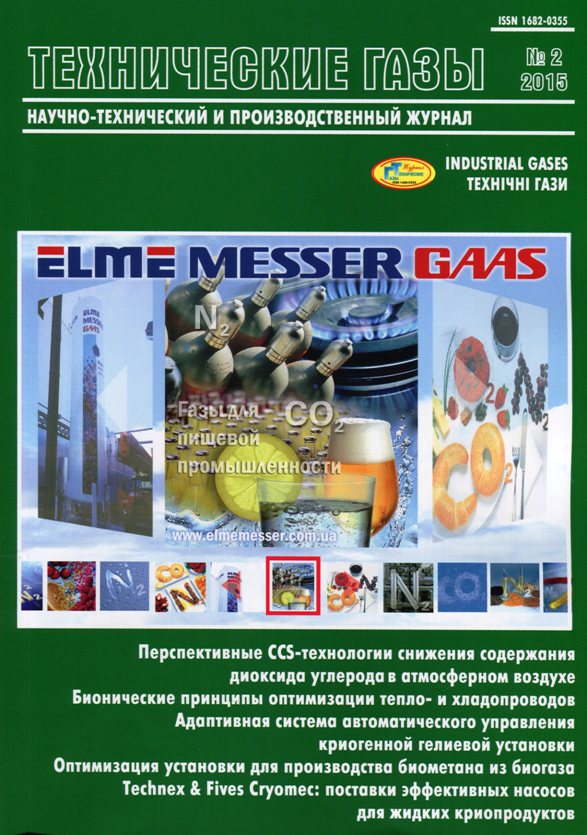ОЦЕНКА ХАРАКТЕРИСТИК АММИАЧНОЙ ХОЛОДИЛЬНОЙ УСТАНОВКИ ПРИ РАБОТЕ КОНДЕНСАТОРА В НЕРАСЧЁТНЫХ УСЛОВИЯХ
DOI:
https://doi.org/10.18198/j.ind.gases.2015.0769Ключевые слова:
Аммиачная холодильная установка, Конденсация аммиака, Воздушный конденсатор, Поверхность теплообмена конденсатора, Температура конденсации аммиака, Температурный напор, Плотность теплового потока, Расход аммиака, Производительность, Потребляемая мощностьАннотация
Показатели аммиачной холодильной установки (АХУ) зависят от эффективности работы конденсатора. Наибольшему влиянию подвержены АХУ с воздушными конденсаторами аммиака. Они проектируются при вполне определённых заданных параметрах, которые характеризуют его работу в расчётном режиме. Создана методика расчёта основных показателей конденсатора крупной АХУ при работе его в нерасчётных режимах. Это позволило проанализировать характеристики АХУ при изменении температуры окружающей среды. Результаты расчётов ряда характеристик аммиачной холодильной установки показали хорошую сходимость с экспериментальными данными.
Библиографические ссылки
Lavrenchenko G.K., Kopyitin A.V., Timoshevskaya L.V. (2014). On the reduction of inerts influence on the ammonia refrigeration installation characteristics// Tekhnicheskie Gasy. [Industrial Gases]. — № 2. — P. 20-29. (Rus.).
Lavrenchenko G.K., Kopyitin A.V., Timoshevskaya L.V. (2014). The analysis of deaeration systems of the ammonia refrigeration installation// Tekhnicheskie Gasy. [Industrial Gases]. — № 3. — P. 18-23. (Rus.).
Byikov A.V., Gogolin A.A., Martyinovskiy V.S. et. al. (1982). Refrigeration machines. — М.: Light and food industry. — 223 p.
Bambushek E.M., Buharin N.N., Gerasimov E.D. et. al. (1987). Thermal and structural calculations of refrigerating machines/ Under the total. Ed. I.A. Sakun. — L.: Mashinostroenie. — 423 p. (Rus.).
Koshkin N.N., Sakun I.A., Bambushek E.M. et. al. (1985). Refrigeration machines/ Under the total. Ed. I.A. Sakun. — L.: Mashinostroenie. — 510 p. (Rus.).
Gerasimov E.D. (1986). Improving the algorithm for calculating condensers and evaporators of refrigerating machines// Kholodilnaya Technika. [Refrigeration Engineering]. — № 8. — P. 35-37. (Rus.).
Philpott C., Deans J. (2004). The enhancement of steam condensation heat transfer in a horizontal shell and tube condenser by addition of ammonia// Intern. J. of Heat and Mass Transfer. — V. 47. — No. 17. — P. 3683-3693.
Love R. J., Cleland D. J., Merts I., Eaton B. (2005). What is the optimum compressor discharge pressure set point for condensers?/ EcoLibrium (August 2005). — P. 24-29.
Cong-gui X. (2013). Heat Transfer Technology Research Development in Horizontal Ammonia Condenser// Petro-Chemical Equipment. — V. 1. — P. 011-021.
Kim Y., Kang B. H. (1998). Numerical Analysis of an Air-cooled Ammonia Condenser with Plate Fins// Intern. J. Of Air-Conditioning and Refrigeration. — V. 6. — P. 104-112.
Chiriac F., Ilie A., Dumitrescu R. (2003). Ammonia Condensation Heat Transfer in Air-Cooled Mesochannel Heat Exchangers// «ASME-2003» International Mechanical Engineering Congress and Exposition. — American Society of Mechanical Engineers, — P. 109-117.
Загрузки
Выпуск
Раздел
Лицензия
ЛИЦЕНЗИОННЫЙ ДОГОВОР
После приёма статьи к публикации редакция согласно требованиям наукометрических баз каждому из авторов направляет лицензионный договор об уступке и передаче в управление авторских прав. Подписи автора (авторов) желательно скрепить печатью отдела кадров учреждения, в котором работает автор (авторы), или печатью факультета.
Редакция отсылает авторам одну верстку для корректуры. Допустимы лишь те исправления, которые приводят верстку в соответствие с исходным текстом статьи. Внесение существенных изменений не допускается. Верстку следует выслать в редакцию в течение суток с момента получения.

